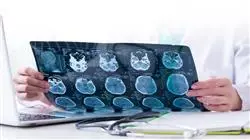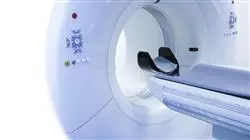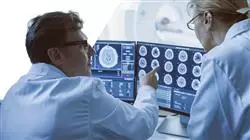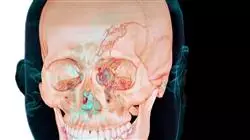University certificate
The world's largest faculty of medicine”
Description
With this Postgraduate diploma, based on Relearning, you will address the significant radiological images to clarify causes of deaths during criminal investigations"

More and more healthcare entities are calling for the incorporation of specialists with a high degree of specialization inRadiology of Trauma with firearms and explosives. These physicians are in charge of analyzing and interpreting radiological images to evaluate internal injuries caused by the impact of projectiles from objects such as guns, rifles, rifles and explosives. In this way, they determine the trajectory of the bullets inside the victim's body and the sequence of events that led to the victim's death. In addition, these professionals translate their findings into detailed reports that can be presented as scientific evidence in different legal proceedings.
For this reason, TECH implements a Forensic Radiology in Bone Trauma in Forensic Radiology in Bone Trauma that will delve into the various injury patterns generated by firearms, as well as the characterization of wounds. The didactic materials will delve into the most innovative radiological techniques for the study of blunt weapon injuries. Therefore, experts will acquire advanced skills to master modern tools such as Magnetic Resonance Imaging, Computerized Axial Tomography or X-rays. At the same time, the syllabus will deal with the Virtual Autopsy procedure, so that graduates can examine the tissues and internal organs of the body without the need to make incisions or physical dissections on the corpses.
TECH offers a 100% online educational environment, tailored to the needs of health professionals seeking to advance their careers. In addition, it uses the revolutionary Relearningmethodology, consisting of the repetition of key concepts to fix knowledge and facilitate learning. Therefore, the combination of flexibility and a robust pedagogical approach makes the university program highly accessible. The only thing experts will need is a device with Internet access to enter the virtual platform and enjoy an educational experience that will take their professional practice to a higher level.
The 100% online methodology of this university program will allow you to obtain an optimized learning without leaving your own home"
This Postgraduate diploma in Forensic Radiology in Bone Trauma contains the most complete and up-to-date scientific program on the market. The most important features include:
- The development of practical cases presented by experts in Forensic Radiology
- The graphic, schematic and eminently practical contents with which it is conceived gather scientific and practical information on those disciplines that are indispensable for professional practice
- Practical exercises where the self-assessment process can be carried out to improve learning
- Its special emphasis on innovative methodologies
- Theoretical lessons, questions to the expert, debate forums on controversial topics, and individual reflection assignments
- Content that is accessible from any fixed or portable device with an Internet connection
You will handle Computed Axial Tomography and obtain detailed images in cross sections of the body to detect even internal hemorrhages"
The program’s teaching staff includes professionals from the field who contribute their work experience to this educational program, as well as renowned specialists from leading societies and prestigious universities.
The multimedia content, developed with the latest educational technology, will provide the professional with situated and contextual learning, i.e., a simulated environment that will provide immersive education programmed to learn in real situations.
This program is designed around Problem-Based Learning, whereby the professional must try to solve the different professional practice situations that arise during the course. For this purpose, the student will be assisted by an innovative interactive video system created by renowned and experienced experts
You will have at your disposal the most advanced radiological techniques for the study of injuries caused by sharp weapons. You will make the most accurate diagnoses"

This program will make you a more complete professional by equipping you with the most effective resources to meet today's challenges in radiological image interpretation"
Syllabus
Comprised of 3 comprehensive modules, this Postgraduate diploma will provide specialists with a holistic approach to Forensic Radiology in Bone Trauma. The syllabus will delve into the injury mechanics of blunt elements, allowing physicians to determine the force and direction of the impact that caused the injury. In this sense, the syllabus will delve into the most innovative radiobiological techniques, among which Computed Axial Tomography or X-rays stand out. In this way, physicians will develop advanced skills to identify traumatic bone injuries (such as dislocations, traumatic injuries or firearm wounds).

A comprehensive update on Radiological Imaging in the search and retrieval of evidence that will optimize your medical practice"
Module 1. Forensic Radiological Techniques of Bone and Dental Trauma with Blunt Objects
1.1. Classification of Blunt Profile Injury Elements
1.1.1. Blunt Weapons
1.1.2. Blunt Objects
1.1.3. Blunt Mechanical Force Injuries
1.1.4. Structural Injuries
1.1.5. Short Blunt Injuries
1.2. Injury Mechanics of Blunt Elements
1.2.1. Blunt Weapons
1.2.2. Blunt Objects
1.2.3. Blunt Mechanical Force Injuries
1.2.4. Injuries Through Structures
1.2.5. Short Blunt Injuries
1.3. Injury Typologies of Blunt weapons
1.3.1. Superficial Injuries
1.3.2. Deep Injuries
1.3.3. Total or Partial Amputation Injuries
1.4. Types of Injuries Caused by Blunt Objects
1.4.1. Superficial Injuries
1.4.2. Deep Injuries
1.4.3. Total or Partial Amputation Injuries
1.5. Injury Typologies Due to Blunt Injury Mechanics
1.5.1. Superficial Injuries
1.5.2. Deep Injuries
1.5.3. Total or Partial Amputation Injuries
1.6. Injury Typologies of Blunt Structures and Short-Contusive Elements
1.6.1. Superficial Injuries
1.6.2. Deep Injuries
1.6.3. Total or Partial Amputation Injuries
1.7. Marks on the Skeleton of Injuries Due to Blunt Mechanics
1.7.1. Blunt Weapons
1.7.2. Blunt Objects
1.7.3. Blunt Mechanical Force Injuries
1.7.4. Injuries Through Structures
1.7.5. Short Blunt Injuries
1.8. Radiological Techniques for the Study of Blunt Force Injuries
1.8.1. X-Ray
1.8.2. Computerized Axial Tomography
1.8.3. Other Radiographic Techniques
1.9. Radiobiological Techniques for the Study of Injuries of Blunt Objects and Structures
1.9.1. X-Ray
1.9.2. Computerized Axial Tomography
1.9.3. Other Radiographic Techniques
1.10. Radiobiological Techniques for the Study of Blunt Mechanical Injuries and Short Blunt Elements
1.10.1. X-Ray
1.10.2. Computerized Axial Tomography
1.10.3. Other Radiographic Techniques
Module 2. Forensic Radiology of Trauma with Sharp and Cutting Elements
2.1. Classification of Sharp Weapons
2.1.1. Cutting Weapons
2.1.2. Sharp Weapons
2.1.3. Sharps
2.2. Injurious Mechanics of Edged Weapons
2.2.1. Cutting Weapons
2.2.3. Sharp Weapons
2.2.4. Sharps
2.3. Types of Injuries Caused by Cutting Weapons
2.3.1. Superficial Injuries
2.3.2. Deep Injuries
2.3.3. Total or Partial Amputation Injuries
2.4. Injury Typologies of Sharp-Edged Weapons by Sharp Weapons
2.4.1. Superficial Injuries
2.4.2. Deep Injuries
2.4.3. Total or Partial Amputation Injuries
2.5. Injury Typologies of Sharp-Edged Weapons by Sharps
2.5.1. Superficial Injuries
2.5.2. Deep Injuries
2.5.3. Total or Partial Amputation Injuries
2.6. Skeletal Marks from Sharp-Edged Weapon Injuries
2.6.1. Cutting Weapons
2.6.2. Sharp Weapons
2.6.3. Sharps
2.7. Radiological Techniques for the Study of Cutting Weapon Injuries
2.7.1. X-Ray
2.7.2. Computerized Axial Tomography
2.7.3. Other Radiographic Techniques
2.8. Radiological Techniques for the Study of Sharps Injuries
2.8.1. X-Ray
2.8.2. Computerized Axial Tomography
2.8.3. Other Radiographic Techniques
2.9. Radiological Techniques for the Study of Sharps Injuries
2.9.1. X-Ray
2.9.2. Computerized Axial Tomography
2.9.3. Other Radiographic Techniques
2.10. Analysis of Lesions at the Maturation Stage and in Animals
2.10.1. Cutting Lesions in Individuals in Early Stages of Maturation.
2.10.2. Cut Marks on Individuals in Late Stages of Biological Maturation
2.10.3. Cutting Injuries in Animals
Module 3. Radiology of Firearms and Explosives Trauma in Forensic Investigation
3.1. Firearms and Projectiles
3.1.1. Classification of Firearms
3.1.2. Elements that Compose a Firearm
3.1.3. Structure of the Firearm
3.1.4. Firearm Projectiles
3.2. Characterization of Wounds and Firearm Projectile Trajectory
3.2.1. Entrance Orifice
3.2.2. Trajectory
3.2.3. Outlet Orifice
3.3. X-ray Technique and Firearm Projectiles
3.3.1. Number of Projectiles
3.3.2. Probable Trajectory
3.3.3. Probable Caliber
3.3.4. Type of Firearm
3.4. Axial Tomography and Firearm Projectiles
3.4.1. Number of Projectiles
3.4.2. Trajectory
3.4.3. Type of Weapons Used
3.5. Ultrasound and Firearm Projectile
3.5.1. Number of Projectiles
3.5.2. Trajectory
3.5.3. Type of Weapons Used
3.6. Virtual Autopsy in Deaths Caused by Firearm Projectile Wounds
3.6.1. Plain Radiography
3.6.2. Computerized Axial Tomography
3.6.3. Magnetic Resonance Imaging
3.7. Explosives
3.7.1. Typologies of Explosive Elements
3.7.2. Categorization
3.7.3. Mechanics of Explosions
3.8. Classification of Blast Injuries
3.8.1. Primary
3.8.2. Secondary
3.8.3. Tertiary
3.8.4. Quaternary
3.9. Radiodiagnostic Imaging in the Search for and Retrieval of Evidence
3.9.1. Simple Radiography
3.9.2. Computerized Axial Tomography
3.9.3. Magnetic Resonance
3.10. Radiological Assessment of Blast Injuries
3.10.1. Cranial
3.10.2. Cervical
3.10.3. Chest
3.10.4. Abdomen
3.10.5. Extremities

You will enjoy dynamic learning thanks to the variety of multimedia resources provided by this program, including interactive summaries. Enroll now!”
Postgraduate Diploma in Forensic Radiology in Bone Trauma
Forensic radiology plays a crucial role in the investigation of bone trauma cases, helping to identify injuries, determine cause of death and reconstruct events prior to death. Are you passionate about forensic science and looking to specialize in the field of radiology for bone trauma investigation? This Postgraduate Diploma developed by TECH Global University is ideal for you. The program offers you the perfect opportunity to acquire advanced knowledge in this highly specialized field. Through our online program, you will immerse yourself in the study of advanced imaging techniques, such as X-rays, computed tomography (CT), magnetic resonance imaging (MRI) and more. You will also learn how to interpret and analyze radiological images to identify fractures, trauma injuries and other bone abnormalities that can be crucial in criminal and medico-legal investigations.
Get qualified with a Postgraduate Diploma in Forensic Radiology in Bone Trauma
The program's teaching team is made up of experts in forensic radiology and forensic medicine, who will guide you throughout your education and provide you with a unique perspective based on their practical experience in the field. In addition to the technical aspect, our program also focuses on developing communication and teamwork skills, as interdisciplinary collaboration is essential in the field of forensic radiology. As such, you will learn to communicate your findings clearly and concisely, both in written reports and presentations. Upon successful completion of the program, you will be prepared for key roles in the field of forensic radiology, including forensic expert witness, forensic radiologist, criminal investigator and more. The program you acquire will provide you with a valuable, internationally recognized credential that will open doors in the exciting and challenging world of forensic science. Take the opportunity to advance your career and become an expert in forensic radiology. Enroll now and take the first step toward an exciting future in bone trauma investigation!







